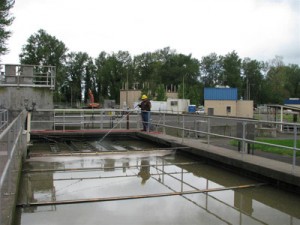Cold, clean, fresh water – how often we take it for granted.
Fortunately, one of the gems comprising Silverton’s uniqueness is its ability to draw on three sources in keeping fresh water flowing to our collective doorstep.
“Most cities draw from a surface source or ground sources,” Silverton Public Works Director Gerald Fisher said. “Some draw from surface with ground as a backup.”
However, to the average home or business owner, what happens between the intake and the output and the intake again can seem shrouded in mystery.
The bulk of the water brought into the Silverton Water Treatment Plant (fresh water) comes from Abiqua Creek. When that is not enough to slake our collective thirst, we can tap Silver Creek. During a drought, we can throw open the gates at the dam to release water into Silver Creek.
The city of Silverton has avoided many potential complications by possessing the water rights to both creeks. In fact, the city’s right to the Abiqua is the oldest water right in Oregon, procured in 1916 from Silverton Lumber Company, which had owned it since pioneer days. Silverton is allowed a certain quota under this entitlement.
The Silverton Dam and Reservoir was constructed from 1972-1975, during which time Silverton secured rights to Silver Creek from the state, Water Quality Division Supervisor Steve Starner said.
“I think this community has used a lot of foresight in establishing this resource; to make sure there is always enough water for everybody here in town to drink,” Starner said.
In addition, the city continues to look ahead. Starner said the hydraulic treatment process at the Silverton Waste Water Plant is designed for a population of 14,000, which is projected for around the year 2030. The WTP has a theoretical treatment capacity of 5.5 MGD, which should provide enough water until 2030.
Fresh water is drawn into the Silverton Water Treatment Plant on Ames Street, where it is filtered and chlorinated.
On average, Silverton residents consume about one million gallons of fresh drinking water a day. Usage peaks to perhaps 3.2 million gallons around the Fourth of July.
The Health Division requires there be a measurable chlorine level at every tap, and its flow regulated at various points to prevent problems for washing machines, dishwashers, etc.
Most decreases in water pressure, Starner said, are due to a necessity of making sure fire hydrants are at the peak of readiness at all times.
Gravity moves used water to Silverton Wastewater plant on Schemmel Lane by way of residential, commercial and industrial drain lines, manholes and lift stations. Here, it undergoes a biological process and is then treated with ultraviolet light before its release into the creek.
Also though, state standards dictate that the water also to be cooled, for, as a whole the stuff that comes in is warm. However, Silverton has another gem in its pocket here – actually a whole handful if you count all the benefits.
“The Oregon Garden is our answer to the temperature problem,” Starner said.
Through a unique, multi-agency partnership, the city of Silverton sends most of its treated effluent – as much as a million gallons a day – to the manmade wetlands at The Oregon Garden, where it cools, is further filtered – all the while being put to good use right on the premises.
“They use it for irrigating all of the formal garden area, and that includes around the resort, too,” Starner said. “The wetlands were constructed to take advantage of the natural slope that moves water from one wetland cell to the next.”
The Silverton City Council recently increased water and sewer rates with the goal of helping fund the $3 million overhaul under way at the wastewater treatment plant.
“The project will rehabilitate two existing anaerobic digesters,” Starner said. “That helps us stay in state compliance and be able to land-apply the bio-solids – a byproduct of the treatment process – that accumulate at the plant.”
The bio-solids are sent to local grass seed farms, repurposed as soil conditioner.
“These are 1982 digesters, so this will replace equipment that is failing; valves that are failing; pumps and that type of thing,” Starner said. The improvements are expected to stand the city about eight years, at which time another – new – digester will be needed.
“The water and sewer funds are enterprise funds, generating revenue from user fees, not taxes like the general fund,” Starner said. “Of the entire city budget, enterprise funds account for 28 percent of the total budget; the general fund accounting for 21 percent.”
The average flow into the plant is about 800,000 gallons per day, Starner said, but winter may bring in an influx upwards of 2 million gallons – not counting floods.
“Floods carry a lot of dirt and debris, so for operators trying to make the drinking water that’s always a challenge,” Starner said. “On the wastewater side, when there is that much water flowing through the community, if there are any cracks or holes in the pipes, that water is collected and brought to the wastewater plant too.”
While the average winter flow into the treatment plant is 2 million gallons per day, it can soar to a volume of 12 million during a big flood/storm event.
Looking ahead, Silverton Public Works intends to take advantage of the city’s sidewalk replacement project – the first phase in the implementation of the Street Enhancement Project of Silverton’s Master Plan. While things are torn up, they plan to replace the 80-year-old iron water main that runs beneath Main Street, along with the outlets to the businesses involved.
“The thought is that as long as you are disrupting things; new construction, you should look at all the city’s utilities in that area, and if anything needs to be fixed, that’s the time to do it,” Starner said.
